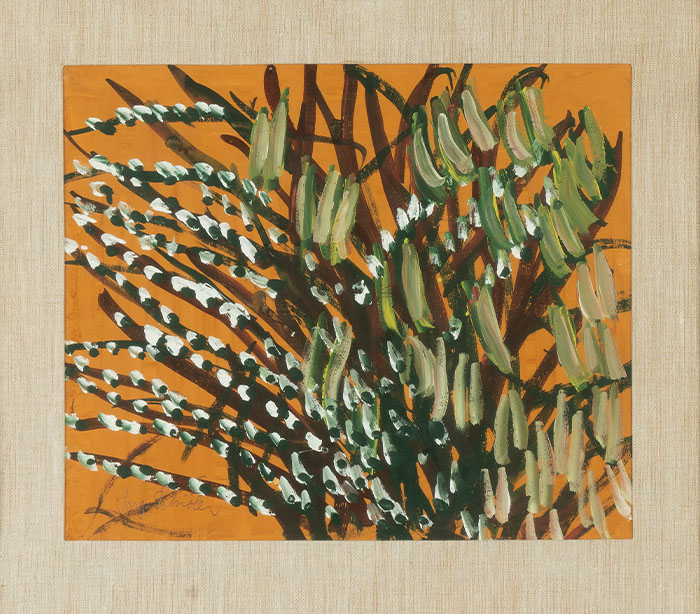Disease art or art created during mental illness has long been of artistic interest because it can be seen as a "decoupled stage" where no ordinary norms or thoughts interfere with the creative process. Inge Schiöler's story is, however, unique in that his period of illness was not the "last phase" in his art production, as it was for Carl Fredrik Hill or Ernst Josephson. Inge Schiöler went through different creative phases, with the disease phase as an "interlude".
Inge grew up in a family with diverse cultural interests: his father was an amateur botanist, and his mother was a musician educated at the Academy of Music. It was a stimulating environment for young Inge that inspired him to become a painter. After various preparatory schools, Inge studied for Tor Bjurström at Valand Art School from 1926 to 1929. According to Bjurström, Inge always worked "... as someone who has a short time at his disposal and probably ruthlessly uses all his hypersensitivity and trembling nervousness". Lue lisää
Inge grew up in a family with diverse cultural interests: his father was an amateur botanist, and his mother was a musician educated at the Academy of Music. It was a stimulating environment for young Inge that inspired him to become a painter. After various preparatory schools, Inge studied for Tor Bjurström at Valand Art School from 1926 to 1929. According to Bjurström, Inge always worked "... as someone who has a short time at his disposal and probably ruthlessly uses all his hypersensitivity and trembling nervousness".
Inge's paintings from the years after Valand are expressive and empathetic. During this period, he mainly painted landscapes. Inge travelled to Spain and France, worked at the Swedish-French gallery's frame workshop and spent the summers at Syd-Koster. In Stockholm, he spent a lot of time with Sven X Ericson, Albin Amelin, Ivar Lo-Johansson and Harry Martinson, among others.
At the beginning of 1933, Inge suffered from the flu, and at the same time, he started to show signs of mental illness. In October of the same year, he was hospitalized at Sankt Jörgen's hospital with the diagnosis of schizophrenia. Inge became apathetic, and no one believed that he would ever be able to paint again. At this time, mental health care was not so developed but mainly consisted of containment and various shock therapies (electric shocks, for example). However, medicinal treatments became more common in the 1930s and 1940s, improving the care results among many patients.
In the spring of 1942, Inge woke up from his apathetic state. It is said that Inge's mental health improved after being visited by family members, and he started to draw and paint again. He painted on everything, and toilet paper was his favourite material. Inge produced large quantities and worked feverishly, and the staff at Sankt Jörgens' hospital had to ask his relatives to send materials such as paper, pencils and crayons.
The works at this auction are all from Inge's intense "re-conquest period", from 1942 to 1946. The motifs are plain but detailed, providing an insight into the "world of the captive man". In these paintings, humans and specific environments are depicted. After 1946, Inge rarely painted people; instead, he portrayed nature and the sea.
Inge was allowed more, and extended leaves from Sankt Jörgen's hospital, often with a supervisor who accompanied him on painting stays in his cottage on Sydkoster. During this period, he started creating large and colour-explosive coastal landscapes made with thickly ironed oil. In 1960, after spending nearly 27 years of his life in hospital, Inge was discharged for good.
Thorsten Bergman was a licensed physiotherapist involved with the Athletics National Team, and travelled with them to six Olympic Games. He was also interested in art and became acquainted with several of the so-called Gothenburg colourists, especially Inge Schiöler and Ragnar Sandberg, whose art he started collecting. He acquired a large number of Inge Schiöler's drawings. Thorsten's family inherited the major part of the collection, and the remaining paintings are now sold at Bukowskis' theme auction.
Viewing 16 – 21 June, Berzelii Park 1, Stockholm
Open hours weekdays 11 am–5 pm, Weekends Closed























